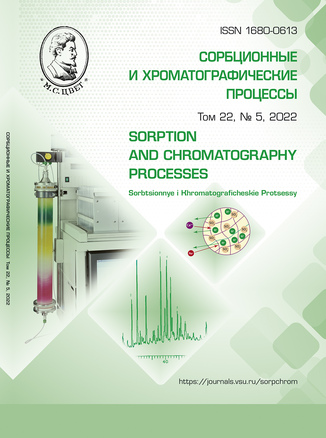Enantioselectivity of liquid chromatographic separation of profens on chiral sorbents with immobilized eremomycin derivatives and oritavancin
Abstract
The patterns of chromatographic retention and the possibility of separating the enantiomers of drugs flurbiprofen, ibuprofen, ketoprofen, indoprofen, and fenoprofen using a hydrophilic high-performance liquid chromatography (HPLC) variant with 5 new sorbents were studied. Sorbents based on silica gel (Kromasil KR-100-7-SIL (Akzo Nobel, Sweden) with a particle diameter of 7 μm, a pore size of 10 nm, and a specific surface area of 313 m2/g) with grafted macrocyclic glycopeptide antibiotics, including oritavancin (O-CSP), eremomycin (E-CSP) and its derivatives chloreremomycin (Chloro-E-CSP), amido-eremomycin (Amide-E-CSP), adamantylamido-eremomycin (Adamantylamide-E-CSP) were used as chiral stationary phases (CSP). The efficiency of chromatographic columns with the length of 250 mm and inner diameter of 4.0 mm used in the study ranged from 14 to 20 thousand theoretical plates per metre. Comparison of sorbents was carried out using 100% methanol with the addition of triethylammonium acetate as an eluent. The obtained enantioselectivity of profen separation decreased in the series O-CSP>Chloro-E-CSP>Adamantylamide-E-CSP>E-CSP>Amide-E-CSP. The highest resolution of chromatographic peaks (Rs > 2.0) was obtained by separating the enantiomers of flurbiprofen, indoprofen, and ketoprofen on sorbents with grafted oritavancin and chloreremomycin.
The study discusses the mechanism for the chiral recognition of enantiomers of 2-phenylpropionic acid derivatives or profens by macrocyclic glycopeptide antibiotics structurally related to eremomycin. It was found that the carboxyl group in the eremomycin molecule plays an insignificant role in chiral recognition, since its conversion to the amide group (Amide-E-CSP sorbent) only slightly reduces enantioselectivity compared to E-CSP. Change of the steric hindrance in the chiral recognition of profens by introduction of an adamantyl substituent into the amide group increases the enantioselectivity of the Adamantylamide-E-CSP sorbent with respect to E-CSP. The most pronounced effect on the enantioselectivity of chiral recognition for the studied sorbents caused a change in the structure of aromatic fragments of eremomycin. The introduction of a chlorine atom into the benzene ring (Chloro-E-CSP sorbent) and addition of pair-phenyl-pair-benzyl substituent (O-CSP sorbent) provided the highest enantioselectivity for these sorbents among all studied CSP.
Downloads
References
Dalgliesh C.E., The optical resolution of aromatic amino-acids on paper chromatograms. J. Chem. Soc. 1952; 3916-3922. https://doi.org/10.1039/JR9520003940
Scriba G.K.E., Chiral recognition in separation sciences. Part I: Polysaccharide and cyclodextrin selectors. TrAC - Trends Anal. Chem. 2019; 120: 115639. https://doi.org/10.1016/j.trac.2019.115639
Armstrong D.W., DeMond W. Cyclodextrin bonded phases for the liquid chromatographic separation of optical, geometrical, and structural isomers. J. Chromatogr. Sci. 1984; 22(9): 411-415. https://doi.org/10.1093/chromsci/22.9.411
Nesterenko P.N., Krotov V.V., Staroverov S.M. Effect of mobile phase composition on the enantioselectivity of chromatographic separation on a quinine-bonded silica stationary phase. J. Chromatogr. A. 1994; 667(1-2); 19-28. https://doi.org/10.1016/0021-9673(94)89047-1
Hyun M.H., Liquid chromatographic enantioseparations on crown ether-based chiral stationary phases, J. Chromatogr. A, 2016, Vol. 1467, pp. 19-32. DOI: 10.1016/j.chroma.2016.07.049
Welch C.J. Evolution of chiral stationary phase design in the Pirkle laboratories. J. Chromatogr. A. 1994; 666(1-2): 3-26. https://doi.org/10.1016/0021-9673(94)80367-6
Berkecz R., Tanács D., Péter A., Ilisz I. Enantioselective liquid chromatographic separations using macrocyclic glycopeptide-based chiral selectors. Molecules. 2021; 26(11): 3380. https://doi.org/10.3390/molecules26113380
Shamshurin D.V., Zavarzin I.V., Yarovenko V.N., Chernoburova E.I., Krayushkin M.M., Volgin Y.V., Shapovalova E.N., Nesterenko P.N., Shpigun O.A. Thiooxamide chiral stationary phase for liquid chromatography. Mendeleev Comm. 2005; 15(4): 143-145. https://doi.org/10.1070/MC2005v015n04ABEH002110
Armstrong D.W., Tang Y., Chen S., Zhou Y., Bagwlll C., Chen J.R. Macrocyclic antibiotics as a new class of chiral selectors for liquid chromatography. Anal. Chem. 1994; 66(9); 1473-1484. https://doi.org/10.1021/ac00081a019
Kuznetsov M.A., Nesterenko P.N., Vasiyarov G.G., Staroverov S.M. High-performance liquid chromatography of α-amino acid enantiomers on eremomycin-modified silica. J. Anal. Chem. 2008; 63(1): 57-64. https://doi.org/10.1007/s10809-008-1011-x
Staroverov S.M., Kuznetsov M.A., Nesterenko P.N., Vasiarov G.G., Katrukha G.S., Fedorova G.B. New chiral stationary phase with macrocyclic glycopeptide antibiotic eremomycin chemically bonded to silica. J. Chromatogr. A. 2006; 1108(2): 263-267. https://doi.org/10.1016/j.chroma.2006.01.073
Fedorova I.A., Shapovalova E.N., Staroverov S.M., Shpigun O.A. Enantioseparation of derivatives of amino acids on silica modified by macrocyclic antibiotic eremomycin, Sorbtsionnye i khromatograficheskie protsessy. 2015; 15(6): 769-775. (In Russ.)
Kuznetsov M.A., Nesterenko P.N., Vasiyarov G.G., Staroverov S.M. Sorbents with immobilized glycopeptide antibiotics for separating optical isomers by high-performance liquid chromatography. Appl. Biochem. Microbiol. 2006; 42(6): 536-544. https://doi.org/10.1134/S0003683806060020
Reshetova E.N., Asnin L.D. The chromatographic behavior and thermodynamic characteristics of adsorption of profen enantiomers on silica gel with grafted eremomycin antibiotic. Russ. J. Phys. Chem. A. 2009; 83(4): 547-551. https://doi.org/10.1134/S0036024409040062
Reshetova E.N., Asnin L.D. Effect of the ionic composition of a mobile phase on the chromatographic retention of profen enantiomers on a chiral adsorbent with grafted eremomycin antibiotic. Russ. J. Phys. Chem. A. 2011; 85(8): 1434-1439. https://doi.org/10.1134/S0036024411080280
Prosuntsova D.S., Plodukhin A.Y., Ananieva I.A., Beloglazkina E.K., Nesterenko P.N. New composite stationary phase for chiral high-performance liquid chromatography. J. Porous Mater. 2020; 28(2): 407-414. https://doi.org/10.1007/s10934-020-00985-y
Stepanova M.V., Asnin L.D., Boteva A.A., Kudinov A.V. Chromatographic behavior and adsorption thermodynamics of chiral pyrroloquinolones on silica grafted with antibiotic eremomycin. Vestnik Permskogo nazional'nogo issledovatel'skogo polytekhnicheskogo universiteta. Khimicheskaya tekhnologiya i biotekhnologiya. 2018; 4: 20-34. https://doi.org/10.15593/2224-9400/2018.4.02
Bouchair N., Righezza M., Hamdi A., Reversed-phase high-performance liquid chromatographic separation of some 2-arylpropionic acids using vancomycin as chiral stationary phase. J. Iranian Chem. Soc. 2015; 12(6): 921-928.
Lisichkin G.V., Fadeev Y.A., Serdan A.A., Nesterenko P.N., Mingalev P.G.z Furman D.B. Chemistry of grafted surface compounds (Khimiya privitykh poverkhnostnykh soedinenii). M.: Fizmatlit; 2003. 592 p. (In Russ.)







